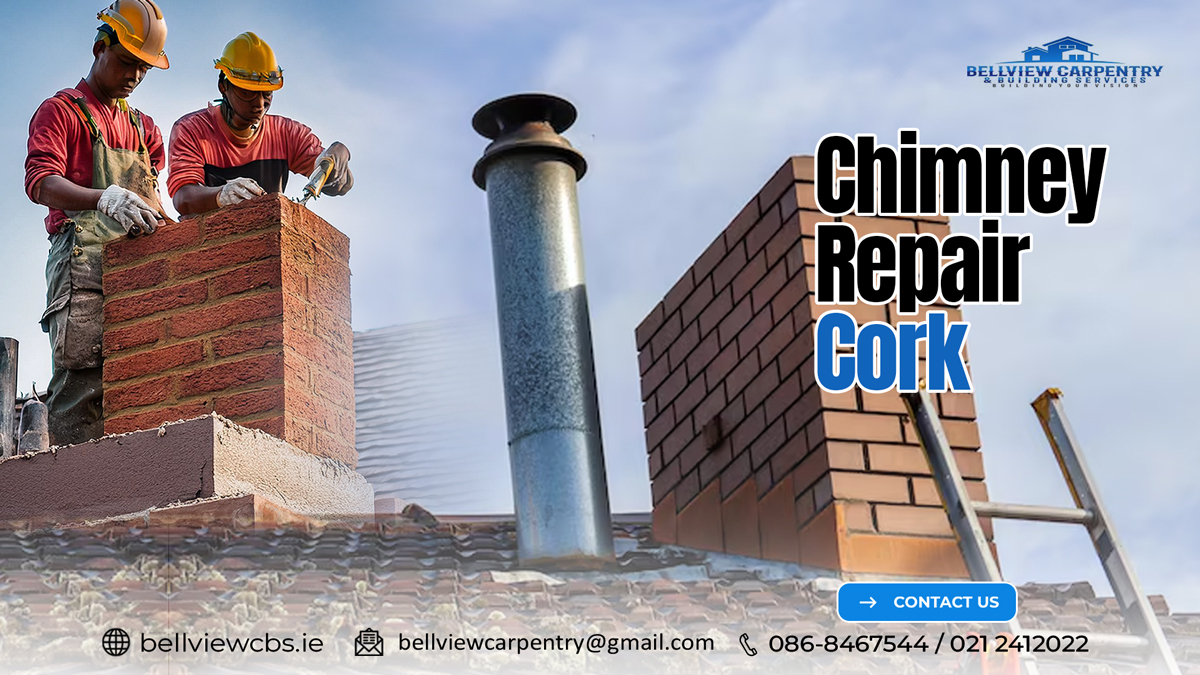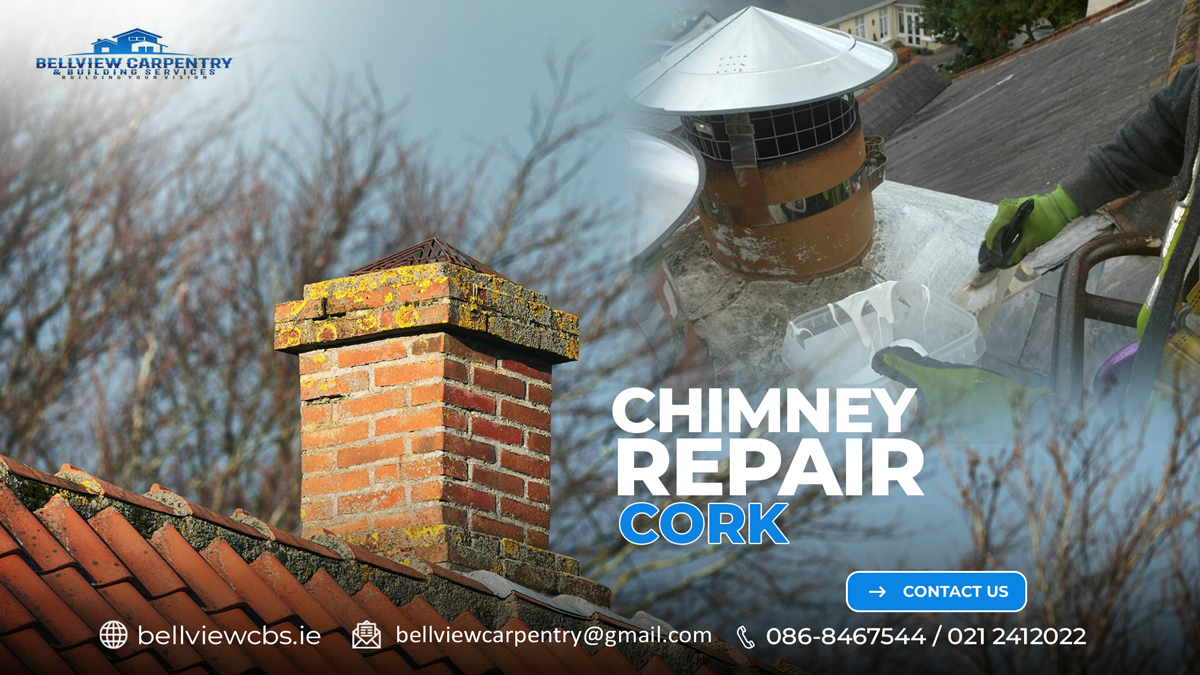A chimney might seem like just another part of your roof, but it plays a vital role in keeping your home safe, warm, and efficient. Over time, weather, age, and regular use can cause damage that’s easy to miss but costly to ignore. Cracked bricks, loose mortar, and blockages can all lead to serious problems if left untreated. That’s why regular Chimney Repair in Cork is essential, especially in those places where damp weather can speed up and maximise the impact of wear and tear. In this blog, we’ll explore why chimney repair matters, how it affects the overall maintenance, and tips to choose the best experts for home renovation service.
How Chimney Issues Can Affect Overall Building Maintenance?
- Water Leaks Can Damage Walls and Ceilings –
Cracks in the chimney structure can allow water to seep into the interior of the building. Over time, this moisture can lead to stained ceilings, damaged walls, and weakened insulation. For property owners relying on Building Maintenance Services Cork, addressing chimney leaks early is essential to prevent costly repairs throughout the home.
- Structural Instability Impacts the Entire Property –
A damaged chimney can affect the structural integrity of the building. Loose bricks, deteriorating mortar, or leaning chimneys pose safety risks and require urgent attention. These structural issues often lead to broader maintenance needs, making chimney repair a key part of complete building maintenance strategies.
- Blocked Chimneys Cause Ventilation Problems –
If the chimney is blocked by debris, soot buildup, or nesting animals, it can disrupt the flow of air. This could create a major ventilation issue in the home. The resulting effect of this phenomenon is an increase in the level of indoor humidity and deteriorating air quality. Maintaining proper ventilation is a core part of any building maintenance plan.
- Increased Risk of Fire Hazards –
Chimney issues like creosote buildup or damaged flue liners significantly raise the risk of house fires. Ensuring that the chimney is clean and in good condition is vital for both safety and overall property upkeep. Regular chimney inspections and timely repairs are essential components of responsible building maintenance duty.
- Compromises the Efficiency of Heating Systems –
A faulty chimney reduces the performance of fireplaces, stoves, and heating systems by preventing smoke and gases from escaping properly. This inefficiency not only raises energy costs but also adds stress to the building’s heating infrastructure. For homeowners seeking efficient building maintenance services, chimney health should never be overlooked.
Why Should One Hire Professionals for Chimney Repair Services?
Well, professional chimney repair experts would always come with experience, knowledge and tools to safely solve the issues without causing any damage. Let’s take a look at what benefits one could receive out of this service –
- In-depth knowledge about chimney construction –
The first step taken towards chimney repair is to have an in-depth knowledge of chimney construction. Chimneys are not only a simple stack of bricks, but they are intricate structures that play a crucial role in maintaining the safety and functionality of the house. Even while repairing, the experts must take this into consideration.
- Knowledge about local building codes –
Hiring an expert offers you the relief that the entire work is done safely by following the local building codes and regulations. Only an expert would have such in-depth knowledge and experience to navigate the complex regulations and requirements and resolve the issue quickly.
- Use of proper tools and equipment –
To repair any issue revolving around the chimney, the experts should have a proper hold of the required tools and equipment. A professional chimney repair technician will have easy access to the use of specialised tools and equipment that are required for effectively repairing the chimney. On top of that, the in-depth knowledge and extensive experience would help them to repair the chimney correctly.
- Use of superior quality materials –
The materials used for repairing the issue in the chimney play a big role in extending the longevity and effectiveness of the entire repair work. The professionals have easy access to use those materials that are specifically designed for chimney repair, making sure that the job is done right the first time.
- Prevents further damage –
As discussed, a professional repairman has the expertise and experience to identify any underlying issues that could potentially worsen over time. So, if you do not want to risk paying off any unwanted repair amount, then make sure to hire a professional and keep your home safe and secure.
Tips to Choose the Best Professionals for Home Renovation Services
- Research local home renovation services
Start by searching for reputable home renovation service providers’ names. Look for companies with strong local presence and positive reviews. Choosing professionals familiar with your area’s building regulations and climate. This ensures that you would receive smoother project management and better results tailored to your area.
- Check credentials and certifications
Verify that the renovation professionals hold the necessary documents. Proper credentials indicate they meet industry standards and comply with safety regulations. This is crucial for peace of mind and protecting your investment during any home renovation project.
- Review previous work and customer testimonials
Ask to see portfolios or case studies of completed projects. Reading customer testimonials and online reviews about their Home Renovation Services in Cork provides insight into their workmanship, reliability, and customer satisfaction. A proven track record is a strong indicator of quality service.
- Get detailed quotes and transparent pricing
Request detailed quotes from multiple home renovation companies to compare pricing and services offered. Transparent pricing helps to avoid unexpected costs later and ensures that the professionals understand your project scope clearly, making the renovation process more efficient and budget-friendly.
- Communication and professionalism matter
Choose renovation professionals who communicate clearly and promptly. Good communication ensures your ideas and concerns are understood and addressed throughout the project. Professionalism in interactions and contracts reflects their commitment to delivering excellent home renovation services to the clients.
Conclusion
Chimney repair is a crucial part of maintaining a safe, efficient, and long-lasting home. Ignoring small issues can lead to major structural damage, costly repairs, and even safety risks. Regular inspections and timely repairs help protect your property and ensure your heating system works properly.
So, whether it’s cracked bricks, water leaks, or ventilation problems, addressing chimney damage early is essential and staying on top of chimney maintenance is more important than ever. Investing in professional chimney repair today can save you from bigger headaches tomorrow.
At Bell View Building Services, each of our works is executed while maintaining the required building regulations and finishing every project to the highest possible standards. We offer a comprehensive range of services that are priced according to the market standards.



